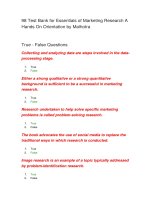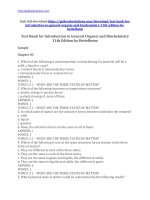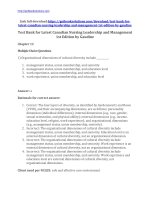Test bank for essentials of human diseases and conditions 4th edition by frazier
Bạn đang xem bản rút gọn của tài liệu. Xem và tải ngay bản đầy đủ của tài liệu tại đây (45.27 KB, 5 trang )
buy this full document at
Frazier: Essentials of Human Diseases and Conditions, 4th Edition
Chapter 1: Mechanisms of Disease, Diagnosis, and Treatment
Test Bank
MULTIPLE CHOICE
1. Signs of disease
a. always cause symptoms.
b. rarely correlate with symptoms.
c. include abnormal objective findings.
d. are always described by the patient.
ANS: C
2. Predisposing factors of disease
a. precisely predict the occurrence of disease.
b. make a person or group more vulnerable to disease.
c. never overlap or occur in combination.
d. can all be controlled by prevention.
ANS: B
3. Genetic diseases may be
a. produced by an abnormality in or mutation of the genetic code in a single gene.
b. caused by several abnormal genes.
c. caused by the abnormal presence or absence of a chromosome or an alteration of
the structure of chromosomes.
d. all of the above.
ANS: D
4. Benign tumors
a. tend to remain encapsulated.
b. infiltrate surrounding tissue.
c. do not compress surrounding tissue or obstruct organs.
d. do not resemble the tissue of origin.
ANS: A
5. Malignant tumors
a. tend to infiltrate other tissue.
b. tend to bleed, ulcerate, and become infected.
c. may spread to distant sites in the body.
d. are all of the above.
ANS: D
buy this full document at
Full file at />6. Which statement is true regarding the TNM (tumor, nodes, metastasis) cancer staging system?
a. Assesses the size and extent of the spread of the primary tumor.
b. Is a grading system based on the degree of differentiation of tumor cells.
c. Both a and b are true.
d. Neither a nor b is true.
ANS: A
7. Which of the following correctly states the sequence of an allergic response within the body
most?
a. IgE antibodies enter the body and produce an allergen.
b. The release of histamine sensitizes mast cells and produces symptoms.
c. Exposure to allergen stimulates production of IgE antibodies that can subsequently
trigger symptoms of allergy.
d. Histamine produces mast cells, which stimulate plasma cells.
ANS: C
8. Which of the following most accurately states the orderly steps in making a diagnosis?
a. Medical history, physical examination, diagnostic tests, diagnosis, integration of
results, treatment
b. Medical history, diagnostic tests, physical examination, treatment plan
c. Physical examination, medical history, radiographs, prognosis, and integration of
all information
d. Comparison of normals, physical examination, history, treatment plan, and
prognosis
ANS: A
9. Mechanical and chemical barriers, the inflammatory response, and the immune response are
a. risk factors for disease.
b. the combined effects of inheritance and environmental factors.
c. included in the body’s natural defense system against infection.
d. agents that damage DNA.
ANS: C
10. Immunodeficiency disorders result from
a. an exudative response.
b. physical trauma.
c. motor vehicle accidents.
d. a depressed or absent immune response.
ANS: D
11. Homeostasis refers to
a. disease related to age.
Elsevier items and derived items © 2009 by Saunders, an imprint of Elsevier Inc.
Full file at />b. internal stability of the body.
c. a chronic disease process.
d. genetic predisposition to disease.
ANS: B
12. Pathogens cause disease by
a. invasion of living tissue.
b. destruction of living tissue.
c. intoxication.
d. all of the above.
ANS: D
13. The normal protective physiologic response(s) to tissue injury and disease is (are)
a. infection.
b. acute inflammation.
c. cachexia.
d. all of the above.
ANS: B
14. Anaphylaxis, serum sickness, arthralgia, and status asthmaticus are
a. part of aging.
b. systemic manifestations of severe allergic responses.
c. immunodeficiency disorders.
d. mild allergic conditions.
ANS: B
15. Smoking, drinking, nutrition, and lack of exercise are examples of
a. predisposing factors related to age.
b. predisposing factors related to environment.
c. predisposing factors related to heredity.
d. predisposing factors related to life style.
ANS: D
16. In preventative health care the emphasis is on
a. accident intervention.
b. freedom of life style.
c. prophylactic medical services.
d. personal rights.
ANS: C
17. Which statement(s) is(are) true about understanding the patient’s pain?
a. Pain is subjective.
b. Pain has individualized effects.
Elsevier items and derived items © 2009 by Saunders, an imprint of Elsevier Inc.
Full file at />c. Pain is a necessary entity in life.
d. All of the above statements are true.
ANS: D
18. Osteopathy
a. is not practiced by trained medical physicians.
b. emphasizes the body’s natural process to heal and provide well being.
c. does not use manipulation techniques.
d. all of the above.
ANS: B
19. Pain may be described as
a. dull and aching, burning, or throbbing.
b. shooting, dull, stabbing.
c. frightening, intense, tiring.
d. all of the above.
ANS: D
20. The holistic concept of medical care focuses on
a. the needs of the whole person: spiritual, cognitive, social, physical, and emotional.
b. narrowly defining physical pathologic changes.
c. discounting the needs of a patient as a whole to expedite healing.
d. all of the above.
ANS: A
TRUE/FALSE
1. Gene therapy is now a common intervention and proven cure for many diseases.
ANS: F
2. Tumor grade is determined through microscopic evaluation of the tumor or a biopsy specimen.
ANS: T
3. Products lacking FDA approval may mean ingredients listed outside the bottle may not be
inside the bottle or in the amount listed.
ANS: T
4. The use of hormone therapy and immunotherapy in the treatment of cancer continues to
evolve.
ANS: T
Elsevier items and derived items © 2009 by Saunders, an imprint of Elsevier Inc.
Full file at />5. The philosophy of hospice affirms life and neither hastens nor postpones death.
ANS: T
6. Among some common concerns about the health issues of older adults are substance abuse and
nutritional problems.
ANS: T
MATCHING
Match the descriptions with the appropriate terms.
a. Excision of tissue for microscopic examination
b. Tumor, or growth of new tissue
c. Changes in the genetic code of a cell
d. Stimulates the immune system to produce antibodies
1.
2.
3.
4.
Mutation
Antigen
Neoplasm
Biopsy
1.
2.
3.
4.
ANS:
ANS:
ANS:
ANS:
C
D
B
A
Elsevier items and derived items © 2009 by Saunders, an imprint of Elsevier Inc.









